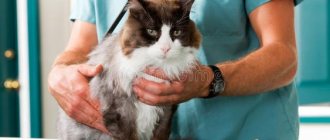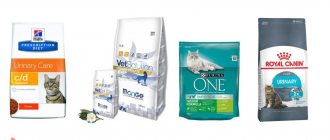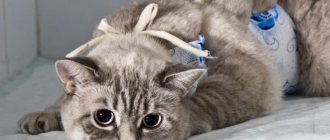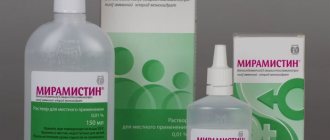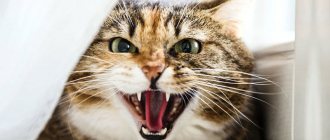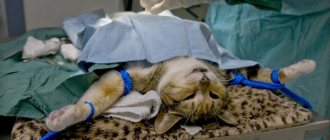The first hours after surgery - your actions
After surgery, the cat begins a rehabilitation period. It needs to be transported home; during transportation it is important to ensure the most comfortable conditions possible. First of all, we recommend purchasing a special container for transporting animals. Lay a soft blanket in it and cover with a waterproof diaper on top. After placing the cat there, cover it with a blanket or warm diaper, because... During anesthesia, body temperature drops, and it is important to prevent hypothermia.
In a normal state, a cat recovers from anesthesia within 1-2 hours. Careful monitoring must be ensured during this time. While the cat is under anesthesia, it may be necessary to lubricate the cornea with a saline solution. In modern clinics, doctors immediately lubricate the animal’s eyes with professional gel - in this case, no additional effort is required from the owner.
In the first minutes after emerging from anesthesia, the cat usually behaves lethargically. Don’t touch her again, don’t pick her up, let her lie down. You can offer your pet water, but you should refrain from eating for a while.
What do veterinarians advise for care?
When it comes to caring for a cat after sterilization, veterinarians’ advice boils down to the following points:
- Clean the tray after each visit. During the recovery period, it is better to make do with pieces of paper.
- Strictly exclude any water procedures. During this period, use wet wipes. You can bathe after the seam is completely closed.
- It is necessary to isolate the cat from other relatives and especially dogs.
- Monitor her bouts of activity - this threatens the sutures coming apart.
- No antibiotics are required. The surgeon gives one injection during the operation.
- If the operation was carried out as usual and the animal is in good health, then the use of vitamins is not required.
- Hemostatic drugs are needed only in case of poor blood clotting.
- Veterinarians advise getting a preventive vaccination. Especially if you are planning to have surgery in a clinic.
Arrangement of a resting place
At home, a four-legged patient needs a special place to rest and sleep. Choose the quietest corner in the apartment, where there are no drafts and crowds of people are kept to a minimum. Lay a blanket directly on the floor, covering it with disposable diapers on top. It is highly not recommended to place the animal on a sofa or chair, because After anesthesia, the cat’s reactions are inhibited, and it can fall from an elevation, damaging its limbs. Cover your pet with a blanket while sleeping.
Place a bowl of water next to the bed. A little later you can bring food. Also place a tray nearby, but be prepared for the fact that the animal may go to the toilet under itself.
"Rimadyl"
Don't know what pain reliever to give to a cat that recently got into a fight with someone? Then we recommend that you use this medicine, which is used by people for wear and tear of cartilage and joints. The undoubted advantage of these tablets is that they also have an anti-edematous effect. So if your pet is suffering from severe bruises, bumps, or bloody wounds, then be sure to give him Rimadyl.
Since the product is considered one of the most effective, it will be quite expensive - about 500 rubles per package. However, you can rest assured that the game is worth the effort. After all, the drug has practically no side effects and pronounced contraindications. It can be used on pregnant and lactating cats, as well as very small kittens. The most important thing is to choose the right dosage.
Cat's diet after surgery
In order for the sutures to heal faster after surgery in a cat, and for the animal to come to its senses more quickly, it is necessary to take care of a nutritious, healthy diet. On the first day after anesthesia, however, it should be very moderate. 5-6 hours after waking up, offer your pet liquid food (chicken broth, for example), but
Important: show your pet due attention, and the recovery period will pass easily and quickly.
Don’t force anyone to eat. On the second day, you can give food in the form of puree.
Attention: during rehabilitation, the serving size should be reduced by approximately 2 times. At the same time, meals can be made more frequent.
Pay special attention to the composition of the products. Currently, there are special foods for cats after surgery, rich in vitamins and minerals. As an alternative or supplement, you can use regular baby food, meat and vegetable purees without salt and sugar.
Veterinarians strongly recommend avoiding spicy foods and foods with strong odors. A weakened digestive system does not accept such food. It is also advisable to exclude the usual dry food from the diet. If the cat is so used to them that it refuses other food, soak the salty pads in water. It is best to give food in the form of canned food. Make sure the food is at a comfortable temperature. Hot food, as well as food just taken out of the refrigerator, has a detrimental effect on digestion.
Preoperative period
He should never be underestimated. Any surgical intervention, whether planned or emergency surgery (procedure), carries certain risks to the life and health of the animal. This is due to the fact that operations and some procedures (manipulations) are performed under general anesthesia (anesthesia). The success of surgery and subsequent recovery directly depends on the preoperative preparation of the pet. During this period, the doctor draws up a general picture of the animal’s condition, determines the severity of the underlying disease and the presence of concomitant disorders (for example, cardiac ones). To minimize risks, the necessary examinations are carried out, and sometimes additional therapy is prescribed.
For healthy animals up to 7 years old
Elective surgeries (for example, spay and neuter) or procedures under anesthesia (ultrasound teeth cleaning, x-rays under sedation) are most often performed without additional examinations of pets. But only if they are under seven years of age and do not have a breed predisposition to heart disease. Such operations are prescribed without first seeing a therapist, and you can sign up for them simply by calling.
For animals over 7 years old or with a history of diseases
Pets in this age category must first see a therapist. This also applies to animals with any diseases (for example, chronic kidney disease or acute liver failure). And in the case of tumor processes, you should make an appointment with an oncologist and surgeon in advance. For such animals, the day of surgery is assigned only after all the necessary examinations.
They must:
- General and biochemical blood test. A general blood test shows the level of leukocytes, red blood (to exclude anemia), and the number of platelets.
- Biochemistry
. It is necessary to assess the functionality of the kidneys and liver in older animals (over 7 years old), since many diseases of the liver, kidneys and heart can occur chronically, without clinical signs and symptoms, and during surgery they can lead to complications and even death of the animal.
Additional tests ordered for some animals
Radiography
It is necessarily carried out to exclude lung pathology, if tumor metastasis is suspected, etc.
Ultrasound
The study is carried out to visually assess the abdominal organs. It is prescribed for suspected presence of free fluid in the chest or abdominal cavity, before cesarean section (including calculating the fetal heart rate), suspected tumor metastases or ruptures of abdominal organs, etc.
Cardiac research
An electrocardiogram (ECG) should be performed on older animals with a history of loss of consciousness, chronic cough, and periodically blue mucous membranes and tongue. It will help identify disturbances in the rhythm and conduction of the heart, as well as a lot of indirect signs of disturbances in the functioning of the heart and its structure.
ECHO of the heart is used to determine the size of the chambers and muscles of the heart, to assess the function and structure of the valves, to detect regurgitation (backflow of blood), etc. It is necessarily carried out in purebred cats to exclude hereditary pathology - hypertrophic cardiomyopathy (HCM). All necessary tests can be completed in one or several days.
After examination and research, you can:
- draw conclusions about the need for surgical intervention (or performing one or another manipulation under anesthesia);
- set the time and date of the operation;
- carry out preoperative therapy in cases of abnormal test results.
It is very important that the animal is as stable as possible before anesthesia.
If the tests are good, surgery is scheduled for the near future.
If the operation is emergency, tests are prescribed individually in each case, taking into account the condition of the animal.
At home the day before surgery
Before surgery, a fasting diet is required:
- for cats – 3–4 hours;
- for dogs – 4–6 hours, except for brachycephalic breeds (with a flat muzzle) – a fast of at least 8–10 hours is recommended for them;
- for puppies and kittens aged 1–6 months - fasting for no more than 4 hours;
- if surgery is planned for interventions on the gastrointestinal tract, gastroduodenoscopy - fasting for 10-12 hours.
The only exception is newborns (up to four weeks of age), they are delivered to the clinic together with nursing mothers.
The countdown is from the beginning of the operation, and not from the moment the animal arrives at the clinic.
For the specified period, absolutely any food should be excluded, and water should not be given 1 hour before the operation. This is due to the fact that when the animal is given sedation or anesthesia, vomiting of feed may occur. If this happens, there is a risk of developing aspiration pneumonia. Therefore, a fasting diet is extremely important.
In the clinic on the day of surgery
On the appointed day, immediately before the operation, the necessary information is collected and the animal is thoroughly examined by an anesthesiologist. Next, the patient is taken to the hospital for the necessary surgical intervention. Pedigree cats undergo cardiac ECHO on the same day (or in advance). After consultations with the anesthesiologist, the pet's owners sign a written consent to give the animal anesthesia and deposit the necessary funds into the balance. The owners' participation is no longer required at this stage; they can leave the clinic.
Seam processing
Until the stitches have healed, the cat should be temporarily isolated from other animals and children, and, if possible, not allowed outside. In the first case, it will be possible to avoid damage to the seams from outdoor games, in the second - their contamination and, as a result, infection. It is also not recommended to wet the seams with water.
During the recovery period, your cat may require dressings. They can be carried out at home. Bandages must be sterile. Before applying the bandage, you need to treat the seam with an antiseptic, which will be prescribed to you by your veterinarian. Most often this is an aqueous solution of chlorhexidine. It is highly undesirable to use iodine and brilliant green for processing.
General information
Let's start with safety precautions, which must be followed regardless of the circumstances. Whether your cat is recovering from a dental cleaning or recovering from abdominal surgery, she will experience toxicity until she fully recovers from anesthesia.
All drugs for anesthesia are, roughly speaking, drugs that lead to muscle relaxation and temporary cessation of the sensitivity of certain areas of the brain. Often, while under the influence of anesthesia, a cat hallucinates, sees pictures, hears sounds or senses something that is not there. All these oddities can prompt your pet to take unexpected actions. Unfortunately, many owners have learned from their own experience that a cat can cause serious injury to itself after anesthesia.
To avoid obvious risks, you should do the following:
- Do not leave your cat unattended until it has completely recovered from anesthesia! It is necessary! If you need to leave for a short time, your pet should be locked in a carrier. To make it more convenient while the cat is sleeping, do not take it out of the carrier, but simply remove the lid.
- Place the carrier with the cat on the floor to prevent the pet from falling. Falling from a height is dangerous because the impact causes the cat to tense up and the seams may come apart.
- Close all windows and vents - yes, some cats very quickly “drop in” from the windows of multi-story buildings if they imagine something.
- Immediately after surgery, put an Elizabethan collar or blanket on your cat (as recommended by your doctor). You may not even notice your cat has woken up, but owners have learned that cats' sharp teeth can remove stitches in seconds.
Note! Even if the cat has undergone a standard, simple operation, all sterility measures must be observed during the rehabilitation period!
After castration of the cat, make sure that he does not remove the collar and that the tray filler is clean. After sterilizing your cat, stock up on several blankets so that you can change them as needed.
On the first day after surgery, the cat will not be able to regulate its temperature, so it is important to keep it warm. Make sure that the carrier is not in a draft. If paws feel cool, use a heating pad. Woolen fabric or special thermal blankets help preserve body heat. If the cat is constantly losing temperature, it is placed on a heating pad with a temperature of 38–39.5°, covered with a light piece of wool and foil.
Important! While the cat is sleeping, it needs to be turned from one side to the other every 1.5–2 hours, this stimulates blood circulation and reduces the risk of developing edema.
Please note that the residual effect of anesthesia may last a day or more. Delayed intoxication also happens, especially if the cat has liver or kidney problems. You need to keep watch over your pet for at least a day, so you need to ask someone for help in advance. The cat will sleep, but not deeply, she will hear most of the sounds, so it is important not to fuss. Even if you are worried, speak in a confident tone and remain as calm as possible. You need to understand that the cat is in pain and scared, and your confidence will support it. If your pet tries to raise its head or stand up, immediately indicate your presence with your voice. Perhaps the cat does not want to go anywhere, and its attempts to move are associated with a feeling of loneliness and fear.
Important! If the animal has a large stitch on its body, for example, after surgery to remove a tumor, strictly follow the doctor's instructions for changing the bandages. A stale bandage can cause the wound to become infected and cause itching, which encourages the cat to make unnecessary movements.
About a day after the operation, you will be faced with a very important question - what to feed and whether it is possible to feed the patient. Please note that if the veterinarian has indicated that you cannot feed the cat, this recommendation must be strictly followed. For example, after intestinal surgery, even a small amount of food will cause damage to the suture or inflammation. Hunger weakens the body, so to maintain it, the cat is given IVs with vitamin complexes and buffer solutions.
Postoperative collar – effective suture protection
During recovery, it is important to ensure that the incision site remains intact: the cat should not lick itself. A postoperative (Elizabethan) collar will help protect the sutures or bandage from harmful intrusions. It is a funnel-shaped structure that is placed around the pet’s neck. The protective edge prevents the cat from licking itself, but at the same time does not interfere with food intake.
An Elizabethan collar for a cat can be purchased at a pet store or you can make it yourself from an old large plastic bottle or thick fabric. In this case, the height of the side should correspond to the distance from the neck to the tip of the animal’s nose.
"Meloxicam"
Do you doubt whether you can give pain medication to your cat? We note especially for our readers: yes, you can. However, not all drugs intended for humans are suitable. In addition, it is important to take into account the recommendations of the attending physician so as not to cause an overdose of the animal body. Otherwise, you risk provoking the development of more serious illnesses, which will sooner or later lead to the death of your pet.
One of the popular remedies used to combat pain in pets is Meloxicam. People often use the tablets for oral diseases or skin lesions. As for furry “patients,” the drug is allowed to be taken for diseases of internal organs or severe injuries to the musculoskeletal system. The cost of the tablets is only 150 rubles.
In what cases should you consult a doctor?
All cats are different, and therefore each one experiences surgery and the post-operative period differently. It happens that not everything goes according to plan, and the help of a veterinarian is required. Therefore, always keep the clinic’s phone number in sight; you may need it in the following cases:
- if body temperature is below 37 °C;
- the cat has not had stool for 3 days or has not urinated for 24 hours;
- purulent discharge came from the stitches, the skin around the incision darkened or swollen;
- after a two-day fast, the appetite does not return, and after taking medications the cat becomes ill (vomiting and behavioral disturbances are observed);
- general health deteriorates.
"Omnopon"
Another pain reliever for cats, which is a mixture of thebaine, narcotine, codeine, papaverine and morphine. Prescribed exclusively for malignant tumors or after surgery. It has a large number of side effects, the most common of which are nausea and respiratory depression. Strictly contraindicated for animals that often suffer from asthmatic attacks.
This anesthetic for cats can be found on sale exclusively in the form of a 1% solution, which is active within five hours. Such a product will cost approximately 500-600 rubles. It is difficult to say exactly how long the package will last, because it depends on the dosage, which, in turn, is prescribed by a specialist and is based on a specific disease. So before use, you should check all the details with your veterinarian.
Signs of pain
Usually cats tolerate pain patiently, but in some cases it is a signal for an urgent visit to the veterinarian.
Signs that your cat is in pain:
- unusual behavior: excessive activity or lethargy;
- unjustified aggressive reactions;
- lack of appetite;
- desire for solitude;
- uncharacteristic apathy and drowsiness;
- refusal of the litter tray;
- drooling and vomiting;
- cardiopalmus;
- heavy or difficult breathing, shortness of breath.
Sterilization or castration?
First of all, the owner of the animal should decide what to do: sterilization or castration. These two procedures are different from each other. In the first case, the ovaries are ligated or the uterus is removed, but the ovaries are not touched. With this operation, estrus continues, but there cannot be kittens. The animal's hormonal levels subsequently become unstable and even in rare cases pregnancy is possible.
Castration involves the removal of both the uterus and ovaries. In this case, estrus stops and the hormonal background after such an operation is more stable, since the adrenal glands are responsible for the production of hormones.
